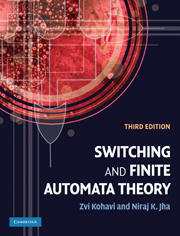Book contents
- Frontmatter
- Contents
- Preface
- Part 1 Preliminaries
- Part 2 Combinational logic
- 3 Switching algebra and its applications
- 4 Minimization of switching functions
- 5 Logic design
- 6 Multi-level logic synthesis
- 7 Threshold logic for nanotechnologies
- 8 Testing of combinational circuits
- Part 3 Finite-state machines
- Index
3 - Switching algebra and its applications
from Part 2 - Combinational logic
Published online by Cambridge University Press: 05 June 2012
- Frontmatter
- Contents
- Preface
- Part 1 Preliminaries
- Part 2 Combinational logic
- 3 Switching algebra and its applications
- 4 Minimization of switching functions
- 5 Logic design
- 6 Multi-level logic synthesis
- 7 Threshold logic for nanotechnologies
- 8 Testing of combinational circuits
- Part 3 Finite-state machines
- Index
Summary
The second part of this book is devoted to combinational logic and deals with various aspects of the analysis and design of combinational switching circuits. The particular characteristic of a combinational switching circuit is that its outputs are functions of only the present circuit inputs. First, switching algebra is introduced as the basic mathematical tool essential for dealing with problems encountered in the study of switching circuits. Switching expressions are defined and are found to be instrumental in describing the logical properties of switching circuits. Systematic simplification procedures of these expressions are next presented; these lead to more economical circuits. Logical design is studied with special attention to conventional logic, complementary metaloxide semiconductor (CMOS) circuits, and threshold logic. Finally, problems related to the testing of combinational circuits for various fault models, and synthesis-for-testability techniques are discussed.
In the current chapter, after developing a switching algebra from the simplest set of basic postulates we show its applications to the study of switching circuits as well as to the calculus of propositions. Finally, this switching algebra is shown to be a special case of Boolean algebra.
Switching algebra
The basic concepts of switching algebra will be introduced by means of a set of postulates, from which we shall derive useful theorems and develop necessary tools that will enable us to manipulate and simplify algebraic expressions.
Fundamental postulates
The basic postulate of switching algebra is the existence of a two-valued switching variable that can take either of two distinct values, 0 and 1.
- Type
- Chapter
- Information
- Switching and Finite Automata Theory , pp. 37 - 66Publisher: Cambridge University PressPrint publication year: 2009



